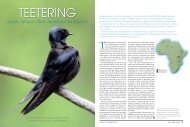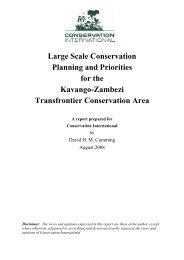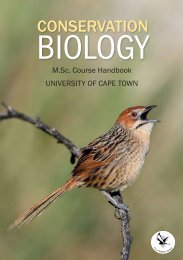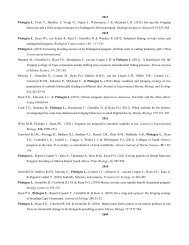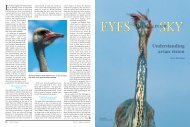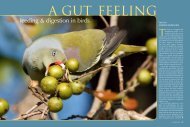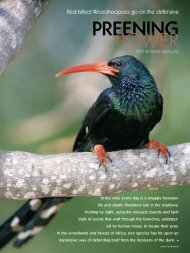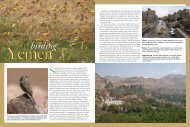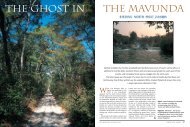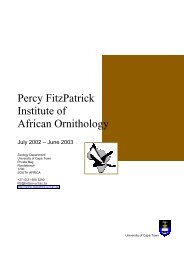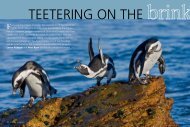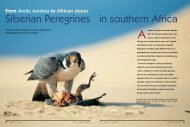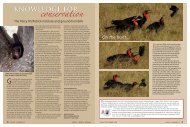Cape Parrot - Percy FitzPatrick Institute of African Ornithology
Cape Parrot - Percy FitzPatrick Institute of African Ornithology
Cape Parrot - Percy FitzPatrick Institute of African Ornithology
You also want an ePaper? Increase the reach of your titles
YUMPU automatically turns print PDFs into web optimized ePapers that Google loves.
steve boyes<br />
graham russell<br />
<strong>Cape</strong> <strong>Parrot</strong> – Sa’s most endangered bird?<br />
The <strong>Cape</strong> <strong>Parrot</strong> Poicephalus robustus is endemic to<br />
South Africa, where it is confined to the eastern<br />
Afromontane forests. The population has collapsed<br />
over the last 50–100 years, and today fewer than 1500<br />
parrots remain in the wild. These two statistics combine<br />
to make the <strong>Cape</strong> <strong>Parrot</strong> Critically Endangered. Worldwide,<br />
parrots have the most threatened species <strong>of</strong> any bird<br />
family: more than 90 <strong>of</strong> the world’s 332 parrot species are<br />
threatened with global extinction. More than 70 <strong>of</strong> these<br />
are threatened by habitat loss, fragmentation or degradation,<br />
and 39 species are threatened by the wild-caught bird<br />
trade, mostly illegally.<br />
The <strong>Cape</strong> <strong>Parrot</strong> is one <strong>of</strong><br />
Worldwide, parrots<br />
have the most<br />
threatened species<br />
<strong>of</strong> any bird family:<br />
more than 90 <strong>of</strong> the<br />
world’s 332 parrot<br />
species are threatened<br />
with global extinction<br />
28 parrot species threatened<br />
by both habitat loss and trade.<br />
Because the <strong>Cape</strong> <strong>Parrot</strong> is one<br />
<strong>of</strong> South Africa’s most threatened<br />
endemic species, researchers<br />
at the <strong>Percy</strong> <strong>FitzPatrick</strong> <strong>Institute</strong><br />
have taken on the challenge <strong>of</strong><br />
helping to save this iconic species<br />
from extinction.<br />
(Above, left) Illegal trapping for the cage-bird trade is a major and<br />
ongoing threat to wild <strong>Cape</strong> <strong>Parrot</strong>s.<br />
Pioneering work by Jack Skead <strong>of</strong> the <strong>Percy</strong> <strong>FitzPatrick</strong><br />
<strong>Institute</strong> and Olaf Wirminghaus <strong>of</strong> the University <strong>of</strong><br />
KwaZulu-Natal showed that <strong>Cape</strong> <strong>Parrot</strong>s are strongly tied<br />
to Afromontane mistbelt yellowwood (Podocarpus) trees for<br />
food and nesting sites. Yellowwoods produce high-quality<br />
hardwood, much in demand for the furniture business,<br />
and have been logged intensively for more than 300 years.<br />
Continued logging by local communities and regulated<br />
harvesting by the government means that the ongoing loss<br />
<strong>of</strong> yellowwoods remains a ‘clear and present danger’.<br />
<strong>Cape</strong> <strong>Parrot</strong>s are further threatened by disease – especially<br />
the airborne Psittacine Beak and Feather Disease (PBFD)<br />
– and by illegal capture for the bird trade. Historically,<br />
<strong>Cape</strong> <strong>Parrot</strong>s were popular cage birds until the population<br />
collapse towards the middle <strong>of</strong> the 20th Century. Recently,<br />
there has been a resurgence in the demand for <strong>Cape</strong><br />
<strong>Parrot</strong>s in captivity fuelled by a combination <strong>of</strong> rarity and<br />
a massive rise in their market value. Of additional grave<br />
concern are several confirmed reports <strong>of</strong> full-blown PBFD<br />
symptoms in wild <strong>Cape</strong> <strong>Parrot</strong>s in the Eastern <strong>Cape</strong>: several
graham russell (3)<br />
<strong>of</strong> these infected birds have already died. We need to act<br />
now to determine the causes <strong>of</strong> this latter problem before<br />
it is too late, because vaccines have been developed that<br />
could possibly be used to mitigate future outbreaks. One<br />
<strong>of</strong> our research aims is to capture as many <strong>Cape</strong> <strong>Parrot</strong>s as<br />
possible to take blood for screening and disease testing,<br />
thus helping us understand and combat this threat.<br />
Our post-doctoral researcher working on the Amathole<br />
<strong>Cape</strong> <strong>Parrot</strong> Project in the Eastern <strong>Cape</strong> spent five years<br />
studying the ecology <strong>of</strong> Meyer’s <strong>Parrot</strong>s P. meyeri in Botswana’s<br />
Okavango Delta in preparation for undertaking this<br />
study on the <strong>Cape</strong> <strong>Parrot</strong>. Our objectives are simple. Based<br />
on sound scientific research into their feeding and breeding<br />
behaviour, coupled with an in-depth study <strong>of</strong> the condition<br />
and productivity <strong>of</strong> the remaining intact Afromontane forest<br />
patches, we aim to develop and implement a conservation<br />
plan that will protect this species into perpetuity.<br />
We will also be taking to the air to track <strong>Cape</strong> <strong>Parrot</strong>s on<br />
their long feeding forays between forest patches, coastal<br />
Wild <strong>Cape</strong> <strong>Parrot</strong>s with advanced symptoms <strong>of</strong> PBFD likely brought on by<br />
poor-quality food.<br />
areas and ‘artificial’ food resources (e.g. pecan nut orchards).<br />
From our bird’s eye view in the microlight, and in<br />
conjunction with our on-the-ground forest surveys, we also<br />
plan to survey forest health using high-definition photography<br />
to develop rapid, accurate and repeatable forest<br />
assessment techniques.<br />
The plight <strong>of</strong> the <strong>Cape</strong> <strong>Parrot</strong> is immediate and<br />
serious, and we have already started this project<br />
with a researcher based in the Amathole Mountains.<br />
Some <strong>of</strong> the costs associated with the project<br />
are high, especially the aerial tracking <strong>of</strong> birds fitted<br />
with radio transmitters. The initial phase <strong>of</strong> the project<br />
is planned to last three years. Although some funding<br />
is already committed to the project, we are urgently<br />
seeking additional sponsorship <strong>of</strong> some $70 000.<br />
Contact Pr<strong>of</strong> Phil Hockey, Director, <strong>Percy</strong> <strong>FitzPatrick</strong> <strong>Institute</strong> and DST/NRF Centre <strong>of</strong> Excellence<br />
E-mail phil.hockey@uct.ac.za • Tel. +27 21 650 3291 • Fax +27 21 650 3295 • Website www.fitzpatrick.uct.ac.za



